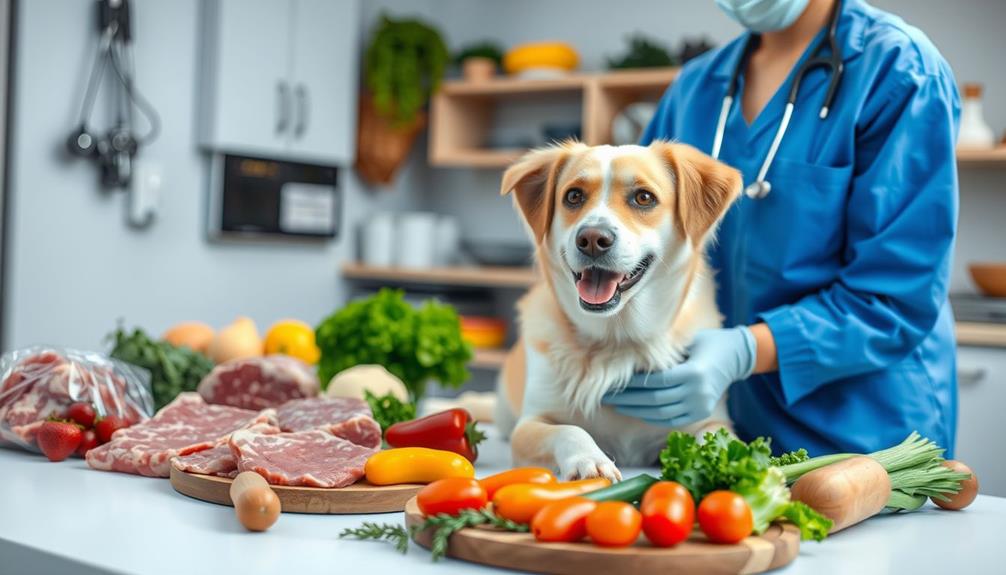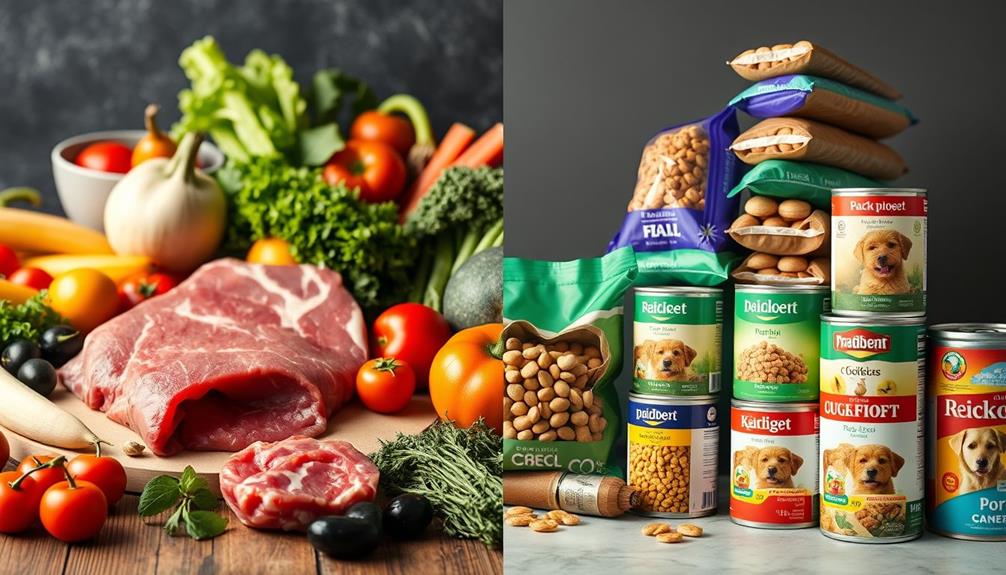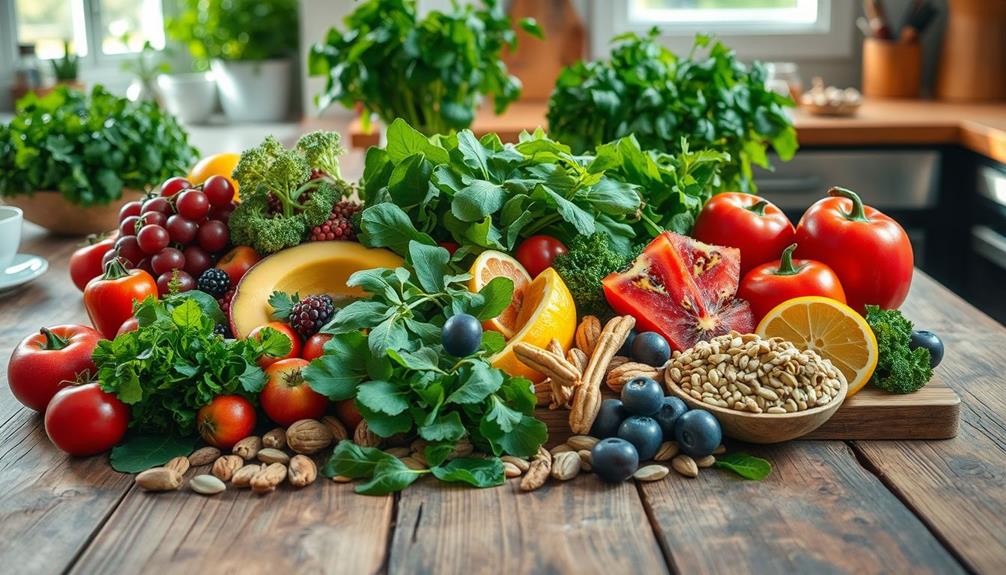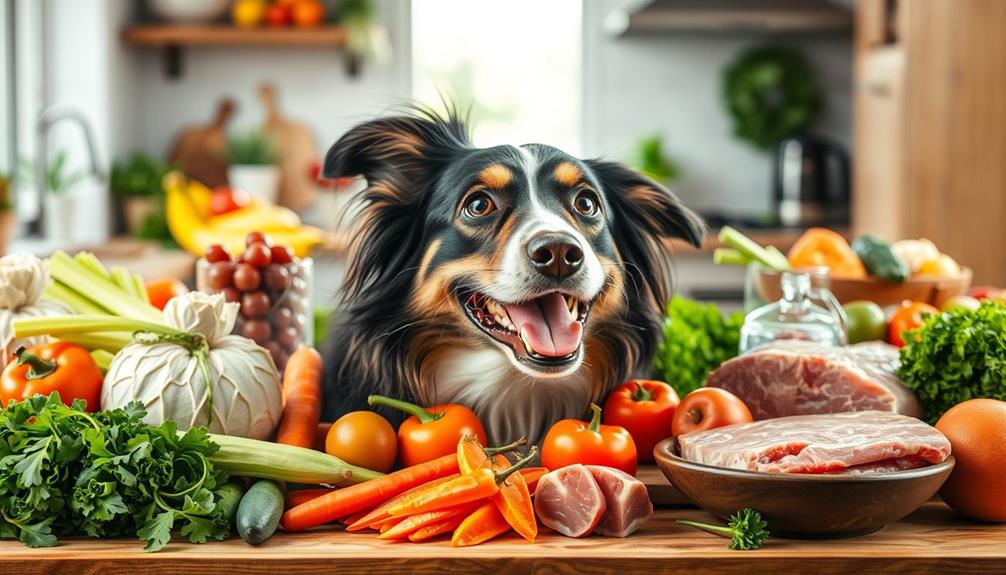A raw food diet for your dog can offer numerous benefits, including improved digestion, shinier coats, and better dental health. By providing high-quality proteins from raw meats and bones, this diet aligns more closely with your dog's natural eating habits, promoting nutrient absorption. You'll likely notice higher energy levels and a strengthened immune system due to the absence of fillers and preservatives. However, it's crucial to consult with a veterinarian to guarantee a balanced diet and mitigate risks. If you're curious about how to shift or what specific nutrients to focus on, there's more to explore.
Key Takeaways
- Raw diets provide high-quality protein and essential nutrients, promoting muscle development and overall health in dogs.
- Improved skin health and shinier coats are common benefits reported by dog owners feeding raw diets.
- Raw meaty bones contribute to better dental hygiene by reducing plaque and promoting fresher breath.
- Easier digestion of raw foods can lead to increased energy levels and enhanced vitality in dogs.
- A well-balanced raw diet may boost the immune system, potentially reducing allergy symptoms and improving overall well-being.
Overview of Raw Dog Food
Raw dog food typically consists of raw meat, bones, fruits, and vegetables, aiming to replicate the natural diets of dogs' wild ancestors. This approach, popularized by veterinarian Ian Billinghurst in 1993 through the BARF (Bones and Raw Food) diet, emphasizes fresh, whole food as primary protein sources.
Proponents argue that raw dog food can provide significant health benefits, including shinier coats, healthier skin, and improved dental hygiene, thanks to the absence of fillers and additives often found in commercial pet food. Additionally, a carefully structured raw diet may support better digestion and increased energy levels, aligning with the principles of ultimate care guides for pets.
However, if you're considering shifting your dog to a raw diet, it's vital to consult veterinary advice. While some dog owners report positive changes in their pets, mainstream veterinarians caution against raw feeding due to potential health risks, such as bacterial contamination and nutritional imbalances.
Ensuring that your dog's diet meets their specific nutritional needs is essential for maintaining a strong immune system and overall well-being. A well-balanced raw diet can be beneficial, but it requires careful planning and knowledge to avoid deficiencies.
Always prioritize your dog's health by seeking guidance from professionals before making any dietary changes.
Nutritional Components of Raw Diet

A well-structured raw diet provides a balanced nutritional profile that closely resembles what dogs would have eaten in the wild. Raw food diets typically consist of raw meat, meaty bones, fruits, and vegetables, ensuring your dog receives the necessary nutrients. High-quality protein from muscle meat and organ meats is essential for muscle development and overall health, helping your dog thrive.
Additionally, incorporating healthy dog snacks can further enhance your dog's diet by adding variety and promoting overall wellness.
One of the significant advantages of raw diets is that they're low in carbohydrates and sugars, promoting better digestion and energy levels. This stands in stark contrast to many commercial kibble options that often contain fillers. The inclusion of raw meaty bones not only offers essential fats but also plays a vital role in dental health. Chewing on these bones helps reduce plaque buildup, keeping your dog's teeth clean.
Moreover, advocates believe raw food diets can enhance nutrient absorption. Without the fillers and preservatives commonly found in commercial dog foods, your dog can more effectively utilize the nutrients in their diet.
Potential Health Benefits

Many dog owners have noticed significant health improvements after switching to a raw food diet. One of the most apparent benefits is improved skin health and a shinier coat. The bioavailability of nutrients and active enzymes in raw ingredients aids nutrient absorption, promoting a healthier appearance.
Furthermore, incorporating fresh, raw foods can provide high levels of antioxidants, similar to how Cranberry Juice Consumption benefits overall health. You might also observe an increase in your dog's energy level; high-quality protein and the absence of fillers allow for easier digestion, enabling your pup to have more energy for playtime.
Additionally, a raw diet can enhance dental health. Raw meaty bones naturally clean your dog's teeth, reducing plaque buildup and promoting fresher breath. You may even find that your dog's stool size decreases and becomes firmer, thanks to the higher digestibility of raw ingredients compared to commercial kibble.
Lastly, many dog owners report a reduction in allergy symptoms after switching to a raw food diet. With fewer fillers and additives that can stress their immune systems, your dog might experience a more comfortable life overall.
Embracing a raw diet could lead to a happier, healthier companion!
Risks and Concerns

While a raw food diet offers various health benefits for dogs, it's important to recognize the potential risks and concerns that come with it. One of the primary issues is bacterial contamination, particularly from pathogens like Salmonella and E. coli, which can impact both your dog's health and your own.
If you're considering raw diets, you need to be aware that an unbalanced diet can lead to nutritional deficiencies or excesses, resulting in severe health problems like bone issues due to improper calcium and phosphorus levels. Additionally, some of the risks associated with certain feeding practices can be compared to the importance of selecting the right cold medications for effective relief.
Additionally, feeding whole bones can present choking hazards or cause internal injuries, including broken teeth, when your dog attempts to chew them.
If your dog has certain health issues, such as kidney failure or pancreatitis, a raw diet may exacerbate these conditions, making it unsuitable for them.
The FDA has raised concerns about the higher incidence of bacterial contamination in raw pet food, emphasizing the need for careful handling and sanitation practices in your kitchen.
Ultimately, you should weigh these risks against the benefits to guarantee your dog's health and well-being.
Guidelines for Transitioning

When shifting your dog to a raw food diet, it's vital to make changes gradually over 7-10 days.
Introducing essential oils for overall health can also be beneficial during this time, as they may support your dog's well-being.
Start by mixing small amounts of raw food with their usual kibble, and keep a close eye on their health throughout the process.
This way, you can catch any issues early and guarantee your dog adjusts smoothly.
Gradual Dietary Changes
Changing your dog to a raw food diet requires a careful approach to guarantee a smooth adjustment. Start by mixing the raw food with your dog's current kibble, using a ratio of about 25% raw to 75% kibble. Over a week or two, gradually increase the raw portion while aiming to shift to a fully raw diet within 7 to 14 days, depending on your dog's tolerance.
It's also important to take into account the nutritional benefits of this diet, as many dog owners report improved energy levels and coat health after switching to raw food importance of a balanced diet.
As you make these changes, it's vital to monitor your dog's reaction closely. Watch for any signs of digestive issues, such as diarrhea or vomiting, and adjust the raw food amount accordingly. Confirm the raw food diet is balanced, incorporating appropriate proportions of proteins, fats, and carbohydrates.
To get the best results, consult with a veterinarian or a certified pet nutritionist for guidance. Additionally, maintain proper hygiene practices when handling raw food to minimize the risk of bacterial contamination.
This will help keep both your dog and your home safe during the shift. With patience and careful observation, you can help your dog adjust to feeding a raw diet, ultimately reaping the benefits of a healthier lifestyle.
Monitor Health Closely
It's essential to monitor your dog's health closely during the shift to a raw food diet. The change can cause gastrointestinal upset, such as diarrhea or vomiting, which may indicate that your dog is adjusting to the new diet.
Additionally, guaranteeing a balanced intake of nutrients is important for your dog's overall health, similar to the benefits of a balanced diet rich in fruits and vegetables for humans.
To facilitate a smooth shift, follow these guidelines:
- Introduce raw food gradually over 7-10 days, mixing it with their current food.
- Keep a detailed record of your dog's diet, health changes, and any symptoms you observe.
- Schedule regular veterinary check-ups to address any potential health concerns.
Watch for changes in your dog's energy levels, coat condition, and stool consistency. These factors are key indicators of how well your dog is adapting to the new diet.
If you notice any unusual symptoms, make necessary adjustments to their food or consult your veterinarian. Monitoring your dog's health closely during this change period guarantees that they thrive on their new raw food diet.
Individual Suitability for Raw Diet

Considering a raw food diet for your dog? It's important to understand that not every dog is suitable for this type of diet. Individual health conditions, such as kidney failure or pancreatitis, may contraindicate its use, making it significant to evaluate your dog's specific dietary needs.
Additionally, just as caregivers must consider financial considerations for elderly care, dog owners should assess their pet's overall health and lifestyle before committing to a raw diet. Puppies require a careful balance of calcium and phosphorus, so a raw diet can be potentially harmful if not properly formulated.
If your dog has a compromised immune system or lives in a household with young children or elderly individuals, you should approach a raw diet with caution due to potential health risks. Before making any changes, a consultation with a veterinarian or certified nutritionist is important. They can help guarantee your dog receives a balanced raw diet tailored to their needs.
As you shift to a raw food diet, regular monitoring for gastrointestinal upset is essential. This will allow you to assess whether the raw diet suits your dog.
Comparison With Other Diets

When comparing a raw food diet to kibble, you'll notice significant differences in nutritional value and digestibility.
Raw diets often provide higher protein levels and bioavailable nutrients, leading to better absorption and overall health.
Additionally, investing in your pet's health through a balanced diet can yield long-term benefits.
You might also find that your dog experiences improved digestion and reduced waste with a raw food approach.
Nutritional Value Comparison
While many dog owners may rely on commercial kibble for convenience, a closer look at the nutritional value reveals significant differences between raw food diets and processed options.
Raw food diets (RMBDs) typically contain high-quality proteins and lower carbohydrates than commercial kibble, which often includes fillers and additives that can lead to obesity and digestive issues. Additionally, pet owners should be cautious with human foods like ice cream, which can have health implications for dogs, especially if they're lactose intolerant. Some pet-friendly ice creams are available, but it's crucial to verify treats don't compromise a balanced diet.
Here are some key nutritional benefits of RMBDs:
- Rich in Antioxidants: RMBDs provide more antioxidants, enhancing immune function and overall health.
- Bioavailable Nutrients: These diets offer whole food sources that allow dogs to absorb nutrients more effectively.
- Healthier Skin and Coats: The higher fat content in RMBDs supports healthier skin and coats compared to lower-fat processed foods.
Although commercial kibble is formulated to meet AAFCO nutrient profiles, it often lacks the natural nutrient diversity found in raw diets.
While RMBDs require careful planning to guarantee balanced vitamin and mineral intake, the nutritional value they offer can lead to healthier, happier dogs. By choosing raw, you're prioritizing your dog's well-being and nutritional needs.
Digestibility and Absorption
Digestibility plays an important role in how well your dog absorbs nutrients from their food. Raw diets generally offer higher digestibility compared to commercial kibble, primarily because they consist of whole foods that align with your dog's natural eating habits. This alignment enhances nutrient absorption, leading to improved health outcomes. The absence of fillers and preservatives allows for better utilization of nutrients, promoting healthier skin and a shinier coat.
Here's a quick comparison of digestibility and absorption among different diets:
| Diet Type | Digestibility Rating | Nutrient Absorption Effect |
|---|---|---|
| Raw Diet | High | Enhanced |
| Commercial Kibble | Moderate | Limited |
| Home-Cooked Meal | Variable | Depends on ingredients |
Studies indicate that the protein source in raw diets is more bioavailable, supporting better muscle development and overall health. Additionally, raw diets often lead to firmer stools and reduced waste, indicating more efficient digestion. Enhanced nutrient breakdown due to active enzymes in raw foods supports best digestive health and contributes to your dog's overall well-being.
Importance of Veterinary Guidance

Changing your dog to a raw food diet can be an exciting journey, but it's essential to seek veterinary guidance first. Consulting with a veterinarian helps you create a balanced diet that meets your dog's nutritional needs and adheres to AAFCO nutrient profiles. This guarantees you avoid potential deficiencies from homemade meals that might be unbalanced.
Veterinary guidance is important for monitoring your dog's health during the changeover. This way, you can quickly address any gastrointestinal upset or adverse reactions that may occur.
Furthermore, your vet can educate you on safe handling practices to reduce the risk of bacterial contamination, a concern with raw diets.
Here are some key points to remember:
- Personalized recommendations: Your vet tailors the raw food diet to your dog's specific health status.
- Ongoing health assessments: Regular check-ups help monitor your dog's nutritional adequacy and overall well-being.
- Preventing risks: Proper guidance minimizes the chances of health issues related to dietary changes.
Long-Term Health Considerations

A raw food diet can offer significant long-term health benefits for your dog, making it worth considering as a permanent dietary choice. By incorporating a balanced raw food diet, you can help improve your dog's overall wellbeing. This diet encourages better weight management, reducing the risks associated with obesity, especially since around 50% of dogs are overweight.
Regularly feeding your dog raw food may also enhance their immune system, lowering the chances of developing allergies that can lead to chronic health issues. You'll likely notice improved skin and a shinier coat, which are indicators of increased liveliness.
However, it's essential to avoid nutritional deficiencies that can result from an unbalanced diet. Consulting veterinarians or nutritionists can help you create a well-rounded meal plan tailored to your dog's needs.
Additionally, a raw food diet promotes dental health. The natural chewing process can reduce plaque buildup, leading to fresher breath over time.
Frequently Asked Questions
Is a Raw Food Diet Good for Dogs?
A raw food diet can be good for dogs, offering benefits like improved energy levels, healthier skin, and reduced odor. You'll notice better digestion and potentially less waste, making for a happier, healthier pup.
Do Vets Recommend a Raw Diet for Dogs?
Isn't it ironic? While some vets caution against raw diets due to safety risks, others may support them for specific needs. Always consult your vet to guarantee your dog's health and nutrition are prioritized.
What Are the Disadvantages of Raw Food for Dogs?
Raw food diets for dogs can pose risks, like bacterial contamination and nutritional imbalances. You might also face challenges with preparation time, costs, and potential health issues for pets with specific conditions.
How Often Should You Feed Your Dog Raw Food?
How often should you feed your dog raw food? You'll typically feed adult dogs once or twice daily, while puppies need three to four meals. Adjust portions based on your dog's weight and activity level.
Conclusion
In summary, a raw food diet can offer numerous benefits for your dog, from improved energy levels to healthier skin. For example, consider Max, a Labrador who struggled with allergies. After shifting to a raw diet, his symptoms greatly decreased, and he became more playful. However, it's essential to confirm this diet suits your dog's needs and to consult your vet for a safe shift. With the right approach, your furry friend can thrive on a raw diet!










